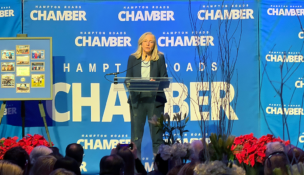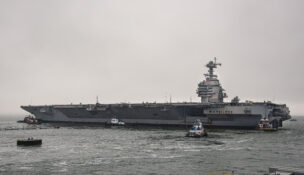Winds of change
Virginia Beach’s $8 billion offshore wind farm moves forward
Winds of change
Virginia Beach’s $8 billion offshore wind farm moves forward
In September, Dominion Energy Inc. unveiled an ambitious, $8 billion project to erect the nation’s largest offshore wind farm off the Virginia Beach coast. If all goes to plan, it will power 650,000 Virginia homes by 2026.
This year, Dominion expects to bring its offshore wind pilot project online and start ocean survey work on the commercial project, which would include 220 massive wind turbines built in three phases. Rising 600 feet above the surface, each turbine would be taller than the Washington Monument.
The first group of turbines — producing 880 megawatts of energy — would be operational in 2024, with additional turbines going into service in 2025 and 2026, ultimately producing 2,600 megawatts. Dominion would be the first electric utility to have sole ownership of an offshore wind farm.
The commercial offshore wind farm is planned for a 112,800-acre site adjacent to Dominion’s Coastal Virginia Offshore Wind (CVOW) project, a pilot venture in which two, 600-foot-tall, 6-megawatt research wind turbines, manufactured by Siemens Gamesa Renewable Energy, will be installed 27 miles off Virginia Beach this spring. Dominion has contracted with Danish firm Ørsted, one of the world’s largest wind-energy developers, to install the turbines on 2,135 acres of federally owned waters leased to the Virginia Department of Mines, Minerals and Energy. In January, Ørsted agreed to lease part of the Portsmouth Marine Terminal from the Virginia Port Authority to stage materials and equipment for the CVOW project, and Dominion selected Siemens Gamesa as its preferred turbine provider for the wind farm.
The $300 million offshore pilot project is projected to be operational by the end of the year, generating 12 megawatts of energy at peak winds, enough to serve 3,000 customers. In October, the U.S. Bureau of Ocean and Energy Management awarded final approval to the pilot, the only offshore wind project permitted in federal waters.
Dominion will use information from the pilot to design and build the wind farm — with hopes for Virginia to become a national leader in the technology, management and deployment of offshore wind energy.
The initiative is in line with Gov. Ralph Northam’s directive to state agencies to develop plans to produce 30% of their electricity from renewable resources by 2030 and be carbon-free by 2050.
“Governor Northam has made it clear that Virginia is committed to leading the way in offshore wind and renewable energy, and we’re rising to the challenge,” says Jeremy Slayton, media relations representative for Dominion Energy.
The company’s offshore wind projects are part of its comprehensive clean energy strategy aimed at achieving net-zero carbon dioxide and methane emissions by 2050.
Currently, turbines and other components used to operate offshore wind projects are manufactured in Europe and shipped to the United States. However, as more commercial wind farms come online, a U.S. supply chain is expected to emerge. Virginia could play a major role in the industry due to its pro-business climate, deep-water ports free of overhead obstructions, maritime workforce and dock capacity, according to a 2018 report prepared by consulting firm BVG Associates.
The United States’ first offshore wind farm began operating off the coast of Rhode Island in 2016, and Maryland and Massachusetts also have similar projects in development.
Doug Smith, president and CEO of the Hampton Roads Economic Development Alliance, predicts that wind energy will have a huge economic impact on the state and the region in the next three to five years, noting that the $70 billion industry could bring 14,000 jobs to Virginia.
“Literally, you’re creating an industry out of whole cloth off the East Coast,” Smith says. “There’s opportunity for Hampton Roads to become the hub for the supply chain for this industry. Ninety percent of the skills needed to put the offshore wind industry into play are skills that we already have in the shipyards and ship repair. These are highly skilled jobs like welders and machinists.”
n
















